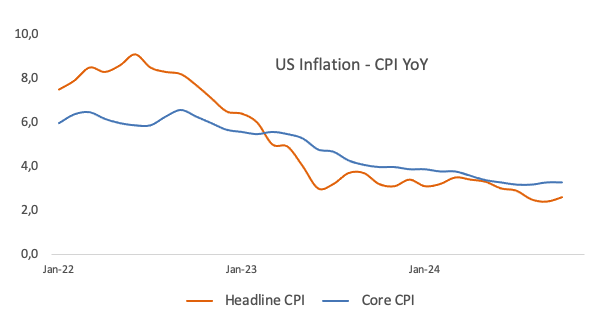The Bureau of Labor Statistics (BLS) reported that the headline Consumer Price Index (CPI) rose by 2.6% last month, matching prior forecasts. Meanwhile, core CPI—which excludes the more volatile food and energy categories—recorded an increase of 3.3% over the last twelve months.
On a monthly basis, the headline CPI rose by 0.2%, and 0.3% when it came to the core reading.
Market reaction to the US CPI
The US Dollar Index (DXY) keeps the corrective decline in place following the uptick in US CPI data in October, hovering around the 105.80 region amidst a marginal retracement in US yields across the curve.
This section below was published as a preview of the US Consumer Price Index (CPI) data at 03:00 GMT.
- The US Consumer Price Index is set to rise 2.6% YoY in October, faster than September’s 2.4% increase.
- Annual core CPI inflation is expected to remain at 3.3% in October.
- The inflation data could significantly impact the market’s pricing of the Fed’s interest rate outlook and the US Dollar value.
The Consumer Price Index (CPI) inflation data from the United States (US) for October, published by the Bureau of Labor Statistics (BLS), is highly anticipated and slated for release on Wednesday at 13:30 GMT.
The US Dollar (USD) is set to rock on intense volatility likely to be spurred by the US inflation report, which could significantly impact the market’s pricing of the Federal Reserve (Fed) interest rate outlook for the coming months.
Follow our US CPI Live Coverage here
What to expect in the next CPI data report?
As measured by the CPI, inflation in the US is expected to increase at an annual rate of 2.6% in October, a tad higher than the 2.4% growth reported in September. The core annual CPI inflation, excluding volatile food and energy prices, will likely remain at 3.3% in the same period.
Meanwhile, the monthly CPI and the core CPI are forecast to rise 0.2% and 0.3%, respectively.
Previewing the October inflation report, TD Securities analysts said: “Inflation readings should remain somewhat firmer than the Fed would prefer in the near-term, reversing some recent improvement in the pace of price changes.”
“We look for headline CPI to rise 0.29% MoM while core inflation rises at a firmer 0.32% MoM pace. This will leave the annual pace of CPI edging up to 2.6% YoY for the headline and remaining steady at 3.3% YoY for core,” they added.
Following the November policy meeting, Fed Chairman Powell maintained that the central bank remains committed to its gradual easing path, adding that the outcome of the US presidential election won’t affect policy decisions in the near term. The Bank seemed determined to defend its independence from newly elected US President Donald Trump, as Powell clearly stated that he would not resign if asked to do so.
How could the US Consumer Price Index report affect EUR/USD?
Trump’s policies on immigration, tax cuts and tariffs could put upward pressure on inflation, calling for higher interest rates and supporting the US Dollar. However, the impact of these policies on the economy and inflation are likely to be felt only in the medium to long term.
Thus, amidst softening labor market conditions and the progress in disinflation, the October inflation report will play a pivotal role in offering fresh hints on the Fed’s next policy move. Markets are pricing in a 67% probability that the Fed will lower rates by 25 bps in December, according to the CME Group’s FedWatch Tool, down from about 80% seen at the start of this month.
The labor data published by the BLS on November 1 showed that Nonfarm Payrolls (NFP) increased by 12,000 last month, following a downward revision to the prior two months. The Unemployment Rate held steady at 4.1% in October. Meanwhile, wage inflation, as measured by the change in the Average Hourly Earnings, rose to 4% over the year in October from 3.9% in September.
A big downside surprise in the US annual headline and core inflation prints could cement expectations of a December Fed rate cut. If the monthly core CPI comes in at 0% or enters negative territory, markets will likely double down bets for an aggressive Fed easing cycle and trigger a USD sell-off. On the other hand, Fed hawks would return and push back against expectations for a rate cut in December on hotter-than-expected CPI readings.
Dhwani Mehta, Asian Session Lead Analyst at FXStreet, offers a brief technical outlook for EUR/USD and explains: “EUR/USD’s near-term technical picture points to a likely buyer exhaustion as the Relative Strength Index (RSI) indicator on the daily chart prods the oversold territory at 30.”
“EUR/USD could meet the initial demand area at the 1.0550 psychological level, below which the November 1, 2023, low of 1.0517 will be challenged. Additional declines will target the 1.0500 round figure. Conversely, interim resistance aligns at the November 11, 2024, high of 1.0728. If buyers recapture the latter sustainably, the next resistance at the 21-day Simple Moving Average (SMA) at 1.0810 will be tested.”
Economic Indicator
Consumer Price Index (YoY)
Inflationary or deflationary tendencies are measured by periodically summing the prices of a basket of representative goods and services and presenting the data as The Consumer Price Index (CPI). CPI data is compiled on a monthly basis and released by the US Department of Labor Statistics. The YoY reading compares the prices of goods in the reference month to the same month a year earlier.The CPI is a key indicator to measure inflation and changes in purchasing trends. Generally speaking, a high reading is seen as bullish for the US Dollar (USD), while a low reading is seen as bearish.
Read more.Last release: Wed Nov 13, 2024 13:30
Frequency: Monthly
Actual: 2.6%
Consensus: 2.6%
Previous: 2.4%
Source: US Bureau of Labor Statistics
The US Federal Reserve has a dual mandate of maintaining price stability and maximum employment. According to such mandate, inflation should be at around 2% YoY and has become the weakest pillar of the central bank’s directive ever since the world suffered a pandemic, which extends to these days. Price pressures keep rising amid supply-chain issues and bottlenecks, with the Consumer Price Index (CPI) hanging at multi-decade highs. The Fed has already taken measures to tame inflation and is expected to maintain an aggressive stance in the foreseeable future.
Fed FAQs
Monetary policy in the US is shaped by the Federal Reserve (Fed). The Fed has two mandates: to achieve price stability and foster full employment. Its primary tool to achieve these goals is by adjusting interest rates. When prices are rising too quickly and inflation is above the Fed’s 2% target, it raises interest rates, increasing borrowing costs throughout the economy. This results in a stronger US Dollar (USD) as it makes the US a more attractive place for international investors to park their money. When inflation falls below 2% or the Unemployment Rate is too high, the Fed may lower interest rates to encourage borrowing, which weighs on the Greenback.
The Federal Reserve (Fed) holds eight policy meetings a year, where the Federal Open Market Committee (FOMC) assesses economic conditions and makes monetary policy decisions. The FOMC is attended by twelve Fed officials – the seven members of the Board of Governors, the president of the Federal Reserve Bank of New York, and four of the remaining eleven regional Reserve Bank presidents, who serve one-year terms on a rotating basis.
In extreme situations, the Federal Reserve may resort to a policy named Quantitative Easing (QE). QE is the process by which the Fed substantially increases the flow of credit in a stuck financial system. It is a non-standard policy measure used during crises or when inflation is extremely low. It was the Fed’s weapon of choice during the Great Financial Crisis in 2008. It involves the Fed printing more Dollars and using them to buy high grade bonds from financial institutions. QE usually weakens the US Dollar.
Quantitative tightening (QT) is the reverse process of QE, whereby the Federal Reserve stops buying bonds from financial institutions and does not reinvest the principal from the bonds it holds maturing, to purchase new bonds. It is usually positive for the value of the US Dollar.
Information on these pages contains forward-looking statements that involve risks and uncertainties. Markets and instruments profiled on this page are for informational purposes only and should not in any way come across as a recommendation to buy or sell in these assets. You should do your own thorough research before making any investment decisions. FXStreet does not in any way guarantee that this information is free from mistakes, errors, or material misstatements. It also does not guarantee that this information is of a timely nature. Investing in Open Markets involves a great deal of risk, including the loss of all or a portion of your investment, as well as emotional distress. All risks, losses and costs associated with investing, including total loss of principal, are your responsibility. The views and opinions expressed in this article are those of the authors and do not necessarily reflect the official policy or position of FXStreet nor its advertisers. The author will not be held responsible for information that is found at the end of links posted on this page.
If not otherwise explicitly mentioned in the body of the article, at the time of writing, the author has no position in any stock mentioned in this article and no business relationship with any company mentioned. The author has not received compensation for writing this article, other than from FXStreet.
FXStreet and the author do not provide personalized recommendations. The author makes no representations as to the accuracy, completeness, or suitability of this information. FXStreet and the author will not be liable for any errors, omissions or any losses, injuries or damages arising from this information and its display or use. Errors and omissions excepted.
The author and FXStreet are not registered investment advisors and nothing in this article is intended to be investment advice.
Recommended content
Editors’ Picks

AUD/USD: Further gains retarget the 200-day SMA
Extra gains saw AUD/USD extend the breakout of the key 0.6500 barrier on Tuesday as hawkish RBA Minutes seem to have lent fresh wings to the Aussie Dollar despite the prevailing risk aversion.

EUR/USD: The recovery needs a stronger catalyst
EUR/USD reversed two daily pullbacks in a row and came under some fresh downside pressure following renewed geopolitical jitters on the Russia-Ukraine front, all prior to key data releases on both sides of the ocean due later in the week.

Gold remains propped up by geopolitics
Gold retreats slightly from the daily high it touched near $2,640 but holds comfortably above $2,600. Escalating geopolitical tensions on latest developments surrounding the Russia-Ukraine conflict and the pullback seen in US yields help XAU/USD hold its ground.

Why is Bitcoin performing better than Ethereum? ETH lags as BTC smashes new all-time high records
Bitcoin (BTC) has outperformed Ethereum (ETH) in the past two years, setting new highs while the top altcoin struggles to catch up with speed. Several experts exclusively revealed to FXStreet that Ethereum needs global recognition, a stronger narrative and increased on-chain activity for the tide to shift in its favor.

How could Trump’s Treasury Secretary selection influence Bitcoin?
Bitcoin remained upbeat above $91,000 on Tuesday, with Trump’s cabinet appointments in focus and after MicroStrategy purchases being more tokens.

Best Forex Brokers with Low Spreads
VERIFIED Low spreads are crucial for reducing trading costs. Explore top Forex brokers offering competitive spreads and high leverage. Compare options for EUR/USD, GBP/USD, USD/JPY, and Gold.
